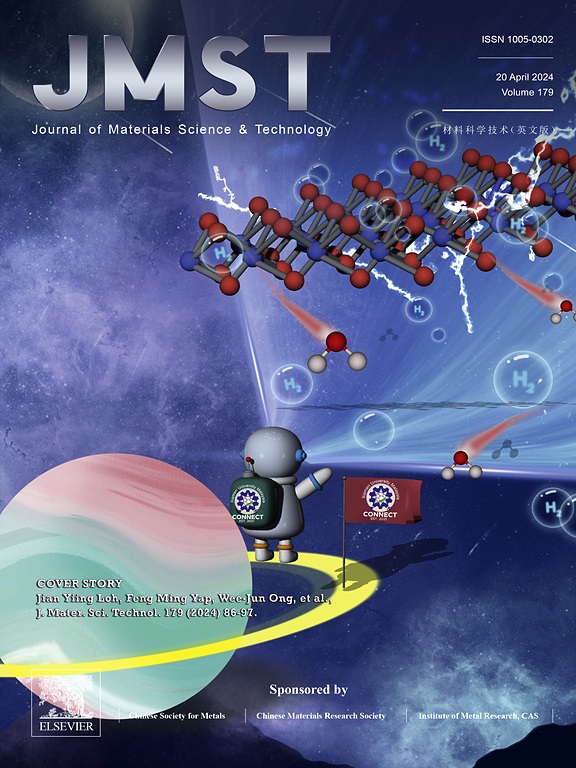晶体Cr/非晶态CrAlN纳米层合材料的层次界面平衡强度-塑性困境
IF 14.3
1区 材料科学
Q1 MATERIALS SCIENCE, MULTIDISCIPLINARY
引用次数: 0
摘要
由韧相和硬相组成的非均相材料被认为具有在保持高强度的同时增强塑性的潜力。本研究采用界面工程的方法,通过在结晶/非晶Cr/CrAlN纳米层合材料中构建分层结构,即以异质界面为界的层状结构和以同质界面(即晶界和玻璃界)为界的柱状结构,来平衡强度-塑性困境。当层厚度从20 nm增加到500 nm时,柱宽基本保持不变。在不牺牲强度和断裂韧性的情况下,随着层厚的增加,纳米层合材料的塑性变形能力大大增强。Cr中的位错滑移和无定形CrAlN中的剪切带激活对纳米层合物的强化起主要作用,但这两个事件都受柱宽度而不是层厚度的控制,从而导致层合物的强度与层厚度无关。同时,层厚相关的塑性受Cr的扭结过程和非晶CrAlN的异质界面诱导结晶的控制。前者由于大量的位错相互作用而允许较大的塑性应变,而后者可能导致CrAlN中的分裂。较大的层厚有利于扭结的形成,可以降低CrAlN层中的结晶率,从而提高塑性。这些机制使Cr/CrAlN纳米层合材料具有可调节的塑性,同时保持不退化的强度。本文章由计算机程序翻译,如有差异,请以英文原文为准。

Balancing the strength-plasticity dilemma via hierarchical interfaces in crystalline Cr/amorphous CrAlN nanolaminates
Heterogeneous materials composed of ductile and hard phases are considered to have the potential to enhance plasticity while maintaining high strength. Here, interface engineering was employed to balance the strength-plasticity dilemma by constructing hierarchical structures in the crystalline/amorphous Cr/CrAlN nanolaminates, which refer to the layered structure bounded by heterointerfaces and the columnar structure bounded by homointerfaces (i.e., grain and glassy boundaries). The column width remains essentially constant as the layer thickness increases from 20 to 500 nm. The plastic deformability of the nanolaminates is found to greatly enhance with raising the layer thickness, without sacrificing strength and fracture toughness. The dislocation slip in Cr and shear band activation in amorphous CrAlN are dominantly contributing to the strengthening of the nanolaminates, while both events are controlled by the column width rather than layer thickness, thereby resulting in the layer thickness-independent strength. Meanwhile, the layer thickness-dependent plasticity is controlled by the kinking process in Cr and the heterointerface-induced crystallization in amorphous CrAlN. The former allows for a larger plastic strain due to the massive dislocation interactions, yet the latter may lead to the splitting in CrAlN. A larger layer thickness is beneficial for the kinking formation and can reduce the crystallization ratio in CrAlN layers, further resulting in higher plasticity. These mechanisms endow the Cr/CrAlN nanolaminates with tunable plasticity while maintaining non-degraded strength.
求助全文
通过发布文献求助,成功后即可免费获取论文全文。
去求助
来源期刊

Journal of Materials Science & Technology
工程技术-材料科学:综合
CiteScore
20.00
自引率
11.00%
发文量
995
审稿时长
13 days
期刊介绍:
Journal of Materials Science & Technology strives to promote global collaboration in the field of materials science and technology. It primarily publishes original research papers, invited review articles, letters, research notes, and summaries of scientific achievements. The journal covers a wide range of materials science and technology topics, including metallic materials, inorganic nonmetallic materials, and composite materials.
 求助内容:
求助内容: 应助结果提醒方式:
应助结果提醒方式:


